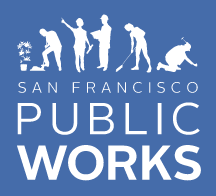Public and Private Partnership Transforms Alley in Hayes Valley into Livable Public Space
PRESS RELEASE
For Immediate Release:
October 25, 2010
Contact: (415) 554-6926
Public and Private Partnership Transforms Alley in
Hayes Valley into Livable Public Space
San Francisco, CA— The Hayes Valley community partnered with the City and County of San Francisco to transform a small alley into a new livable public space. The Department of Public Works (DPW) and the community created the Linden Living Alley project on Linden between Octavia Boulevard and Gough Street to enhance neighborhood connections to outdoor space and follow the trend of several recent city projects that emphasize streetscape improvements that focus on pedestrian use.
“The Linden Living Alley project is an example of communities and city agencies working together to achieve a vision to improve and enhance the public realm in the heart of Hayes Valley,” said Ed Reiskin, Director of the Department of Public Works. “Thanks to their organized leadership, the neighborhood now has a usable public space designed and customized to the needs of the community.”
The transformation included the removal of three parking spaces to widen the sidewalks on the sunny side of the street creating a landscaped place for passersby to take a rest. The road and the sidewalks are at the same level creating a pedestrian-focused space. DPW and the San Francisco Public Utilities Commission (SFPUC) replaced water and sewer main pipelines, reconstructed catch basins, manhole covers, sidewalk and curbs; resurfaced the street, and installed other traffic calming measures. The community contributed to the renovation with sustainable features such as the installation of granite benches which were excavated from the alley and reused to provide seating around generous planted areas that also serve as storm water diversion. The planters also divert and capture 50% of storm water runoff—demonstrating best practices in storm water management and infrastructure projects. Five trees were planted along the alley to enhance and beautify the area.
Architect David Winslow of Winslow Architecture and Urban Design proposed the Linden Living Alley pilot project four years ago. He worked with DPW and the SFPUC to coordinate infrastructure improvements to add greening enhancements to create a livable space where people can enjoy and take in the unique aspects of the neighborhood.
“The success of a public space like this is not easy to achieve,” said David Winslow, who has an office on Linden Alley and describes the redesigned space as an outdoor living room. “What I love about the project was the amazing collaboration and support among neighbors, City departments and other civic-minded people that shared the same vision. I feel through the process alone, we created a better community.”
The project received support from residents, merchants, the Hayes Valley Neighborhood Association, the Neighborhood Parks Council (NPC), and Supervisor Ross Mirkarimi. Improvements to the public realm were funded through a combination of volunteers, in-kind service donations, and monetary contributions from various residents, merchants, and non-profit organizations. The NPC is the fiscal sponsor for the Linden Living Alley project, providing the project with the legal framework it needed to raise funds and enter into a Community Challenge Grant, which awarded $97,800 to the project in 2006 through the City Administrator’s Office. In addition, approximately $78,000 was donated in design services. Sherwood Engineers and Patillo & Garrett Design provided civil engineering and landscape design services, while $30,000 of the project design and management cost were donated by Winslow Architecture. The project also received a $10,000 SEED grant from Studio for Urban Projects in 2009. Adjacent property and business owners pledged $40,000.
“We can increase the impact of a neighborhood park by greening the streets that lead to it. The Linden Alley project is a wonderful example of how greening and traffic calming a neighborhood can enhance the overall community connection to their parks,” said Meredith Thomas, Executive Director of the Neighborhood Parks Council.
DPW is responsible for the care and maintenance of San Francisco’s streets and much of its infrastructure. The department cleans and resurfaces streets; plants and maintains City street trees; designs, constructs and maintains city-owned facilities; inspects streets and sidewalks; constructs curb ramps; removes graffiti from public property; and partners with the diverse neighborhoods in San Francisco to provide stellar cleaning and greening services. For more information, visit www.sfdpw.org
-end-


